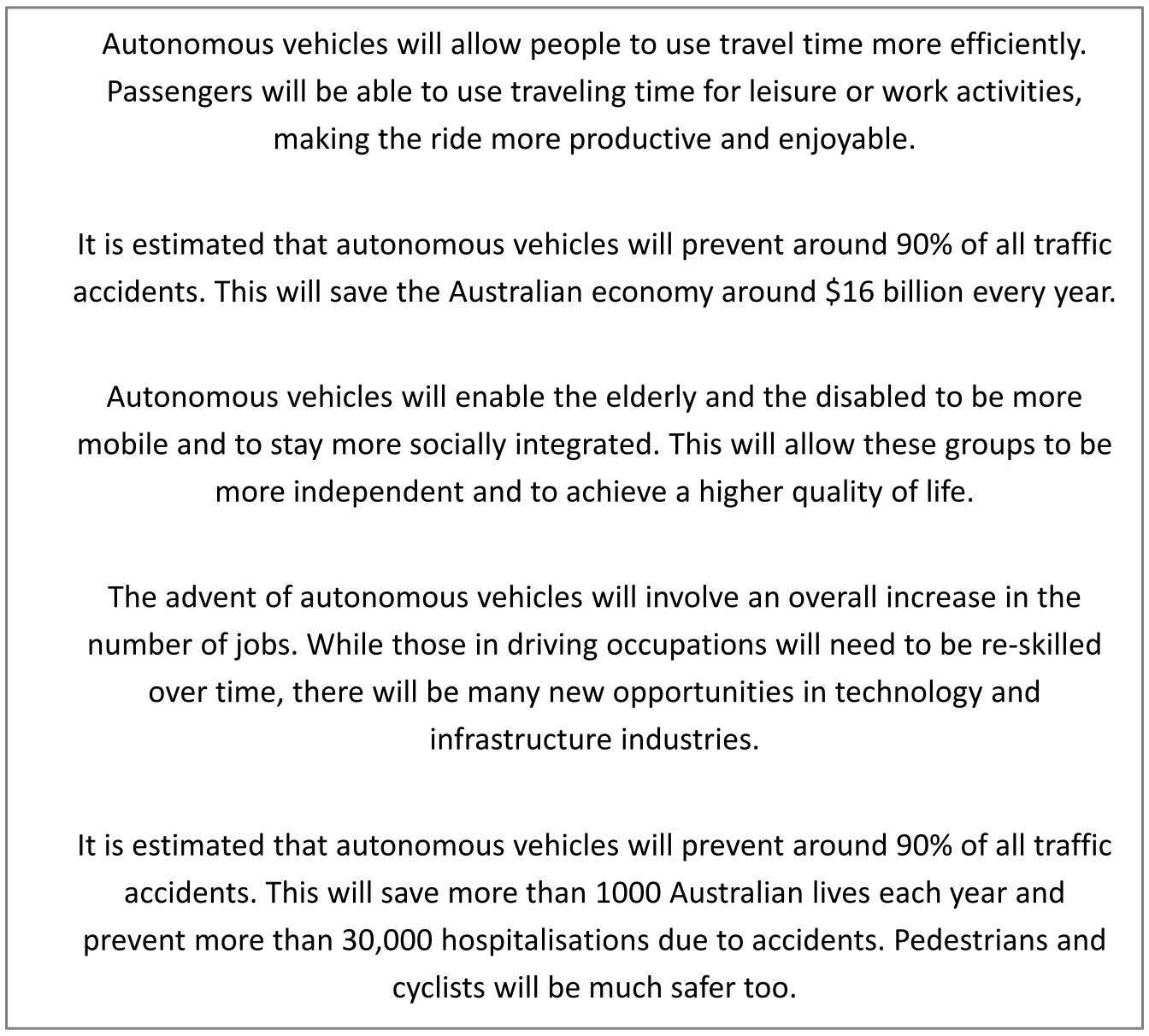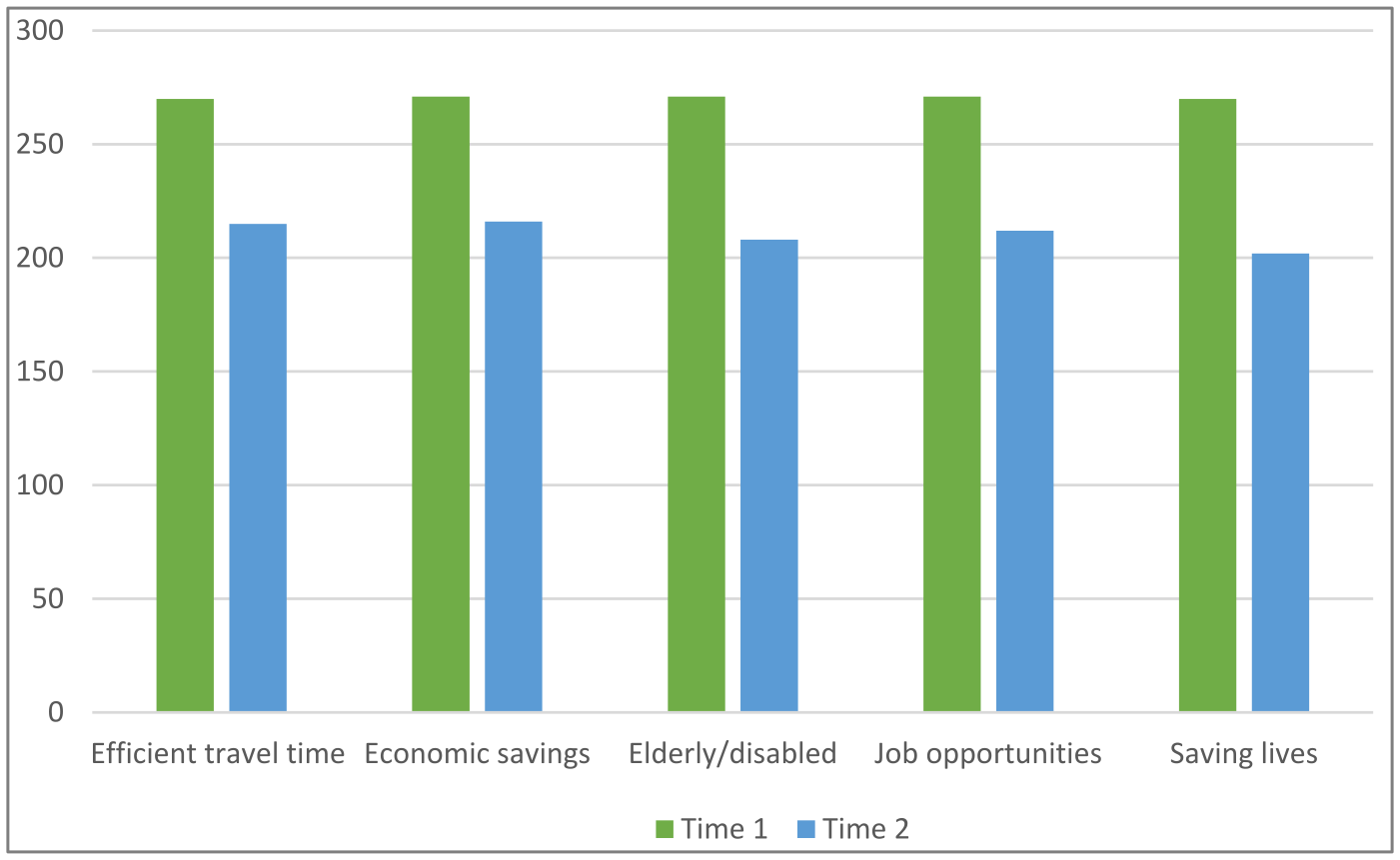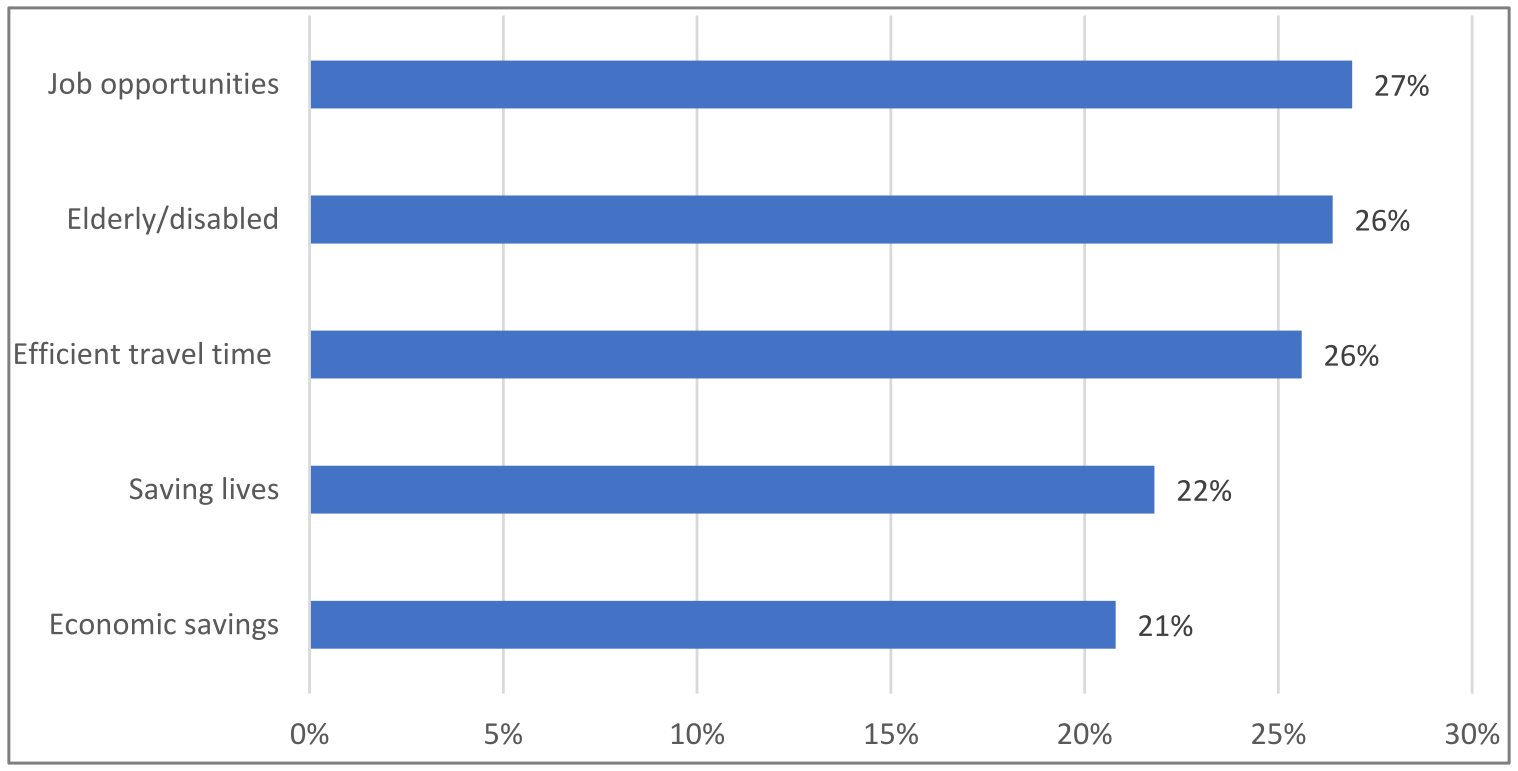Short Note Peer-Reviewed
Perceived Effectiveness of Messages Designed to Promote the Use of Autonomous Vehicles
The George Institute for Global Health, University of New South Wales, NSW 2052 Sydney, Australia
*
For correspondence.
Academic Editor:
Received: 9 January 2023 Accepted: 8 February 2023 Published: 10 February 2023
Abstract
Autonomous vehicles will be a key component of the sustainable cities and transport systems of the future. However, there is little data available on effective methods of communicating with the public about these benefits to optimise uptake and achieve their sustainability potential. The aim of this exploratory study was to assess outcomes associated with exposure to various messages communicating proposed benefits of autonomous vehicles. Australians aged 16+ years (n = 1053) responded to two online surveys administered two weeks apart. The instruments included items relating to demographic attributes, driving factors, and attitudes to autonomous vehicles. Respondents were randomised to one of five messages referring to efficient travel time, economic savings, saving lives, mobility for the elderly and disabled, and job opportunities. Messages relating to saving lives and providing mobility for the elderly and disabled performed best, especially in terms of presenting a strong argument (62% agreement) and believability (67% agreement), respectively. The results provide initial evidence that public awareness communications could favourably influence attitudes to autonomous vehicles, potentially enhancing uptake rates to yield corresponding benefits. This information will be of value in countries where the roll-out of autonomous vehicles is a strategic priority to achieve sustainable cities and transport systems.
Figures in this Article
Keywords
Copyright © 2023
Pettigrew and Booth. This article is distributed under the terms of the Creative Commons Attribution License (CC BY 4.0), which permits unrestricted use and distribution provided that the original work is properly cited.
Funding
Funding for this project was received from the Bankwest Curtin Economics Centre.
Cite this Article
Pettigrew, S., & Booth, L. (2023). Perceived Effectiveness of Messages Designed to Promote the Use of Autonomous Vehicles. Highlights of Sustainability, 2(1), 1–9. https://doi.org/10.54175/hsustain2010001
References
1.
Crayton, T. J., & Meier, B. M. (2017). Autonomous vehicles: Developing a public health research agenda to frame the future of transportation policy. Journal of Transport & Health, 6, 245–252. https://doi.org/10.1016/j.jth.2017.04.004
2.
Fagnant, D. J., & Kockelman, K. (2015). Preparing a nation for autonomous vehicles: opportunities, barriers and policy recommendations. Transportation Research Part A: Policy and Practice, 77, 167–181. https://doi.org/10.1016/j.tra.2015.04.003
3.
Milakis, D., Snelder, M., van Arem, B., van Wee, B., & de Almeida Correia, G. H. (2017). Development and transport implications of automated vehicles in the Netherlands: scenarios for 2030 and 2050. European Journal of Transport and Infrastructure Research, 17(1). https://doi.org/10.18757/ejtir.2017.17.1.3180
4.
Pettigrew, S., Fritschi, L., & Norman, R. (2018). The potential implications of autonomous vehicles in and around the workplace. International Journal of Environmental Research and Public Health, 15(9), 1876. https://doi.org/10.3390/ijerph15091876
5.
Nastjuk, I., Herrenkind, B., Marrone, M., Brendel, A. B., & Kolbe, L. M. (2020). What drives the acceptance of autonomous driving? An investigation of acceptance factors from an end-user’s perspective. Technological Forecasting and Social Change, 161, 120319. https://doi.org/10.1016/j.techfore.2020.120319
6.
Othman, K. (2022). Exploring the implications of autonomous vehicles: a comprehensive review. Innovative Infrastructure Solutions, 7, 165. https://doi.org/10.1007/s41062-022-00763-6
7.
Fleetwood, J. (2017). Public health, ethics, and autonomous vehicles. American Journal of Public Health, 107(4), 532–537. https://doi.org/10.2105/AJPH.2016.303628
8.
Pettigrew, S. (2017). Why public health should embrace the autonomous car. Australian and New Zealand Journal of Public Health, 41(1), 5–7. https://doi.org/10.1111/1753-6405.12588
9.
Rojas-Rueda, D., Nieuwenhuijsen, M. J., Khreis, H., & Frumkin, H. (2020). Autonomous vehicles and public health. Annual Review of Public Health, 41(1), 329–345. https://doi.org/10.1146/annurev-publhealth-040119-094035
10.
Acheampong, R. A., Cugurullo, F., Gueriau, M., & Dusparic, I. (2021). Can autonomous vehicles enable sustainable mobility in future cities? Insights and policy challenges from user preferences over different urban transport options. Cities, 112, 103134. https://doi.org/10.1016/j.cities.2021.103134
11.
Kovačić, M., Mutavdžija, M., & Buntak, K. (2022). New paradigm of sustainable urban Mobility: electric and autonomous vehicles—A review and bibliometric analysis. Sustainability, 14(15), 9525. https://doi.org/10.3390/su14159525
12.
Chehri, A., & Mouftah, H. T. (2019). Autonomous vehicles in the sustainable cities, the beginning of a green adventure. Sustainable Cities and Society, 51, 101751. https://doi.org/10.1016/j.scs.2019.101751
13.
Gružauskas, V., Baskutis, S., & Navickas, V. (2018). Minimizing the trade-off between sustainability and cost effective performance by using autonomous vehicles. Journal of Cleaner Production, 184, 709–717. https://doi.org/10.1016/j.jclepro.2018.02.302
14.
Litman, T. ( 2018). Autonomous Vehicle Implementation Predictions: Implications for Transport Planning. Victoria Transport Policy Institute.
15.
Future Agenda. (2020). The Future of Autonomous Vehicles. Future Agenda. https://www.futureautonomous.org (accessed 12 June 2021).
16.
Graf, A., & Sonnberger, M. (2022). Responsibility, rationality, and acceptance: How future users of autonomous driving are constructed in stakeholders’ sociotechnical imaginaries. Public Understanding of Science, 29(1), 61–75. https://doi.org/10.1177/0963662519885550
17.
Cunningham, M. L., Regan, M. A., Horberry, T., Weeratunga, K., & Dixit, V. (2019). Public opinion about automated vehicles in Australia: Results from a large-scale national survey. Transportation Research Part A: Policy and Practice, 129, 1–18. https://doi.org/10.1016/j.tra.2019.08.002
18.
Barbour, N., Menon, N., Zhang, Y., & Mannering, F. (2019). Shared automated vehicles: A statistical analysis of consumer use likelihoods and concerns. Transport Policy, 80, 86–93. https://doi.org/10.1016/j.tranpol.2019.05.013
19.
Rice, S., & Winter, S. R. (2019). Do gender and age affect willingness to ride in driverless vehicles: If so, then why? Technology in Society, 58, 101145. https://doi.org/10.1016/j.techsoc.2019.101145
20.
Othman, K. (2021). Public acceptance and perception of autonomous vehicles: a comprehensive review. AI and Ethics, 1(3), 355–387. https://doi.org/10.1007/s43681-021-00041-8
21.
Vakratsas, D., & Amler, T. (1999). How advertising works: What do we really know? Journal of Marketing, 63(1), 26–43. https://doi.org/10.2307/1251999
22.
Anania, E. C., Rice, S., Walters, N. W., Pierce, M., Winter, S. R., & Milner, M. N. (2018). The effects of positive and negative information on consumers’ willingness to ride in a driverless vehicle. Transport Policy, 72, 218–224. https://doi.org/10.1016/j.tranpol.2018.04.002
23.
Liu, P., Ma, Y., & Zuo, Y. (2019). Self-driving vehicles: Are people willing to trade risks for environmental benefits? Transportation Research Part A: Policy and Practice, 125, 139–49. https://doi.org/10.1016/j.tra.2019.05.014
24.
Sharma, I., & Mishra, S. Quantifying the consumer’s dependence on different information sources on acceptance of autonomous vehicles. Transportation Research Part A: Policy and Practice, 160, 179–203. https://doi.org/10.1016/j.tra.2022.04.009
25.
Marques Dos Santos, F. L., Duboz, A., Grosso, M., Raposo, M. A., Krause, J., Mourtzouchou, A., et al. (2022). An acceptance divergence? Media, citizens and policy perspectives on autonomous cars in the European Union. Transportation Research Part A: Policy and Practice, 158, 224–238. https://doi.org/10.1016/j.tra.2022.02.013
26.
Du, H., Zhu, G., & Zheng, J. (2021). Why travelers trust and accept self-driving cars: An empirical study. Travel Behaviour and Society, 22, 1–9. https://doi.org/10.1016/j.tbs.2020.06.012
27.
Cunningham, M. L., Regan, M. A., Horberry, T., Weeratunga, K., & Dixit, V. (2019). Public opinion about automated vehicles in Australia: Results from a large-scale national survey. Transportation Research Part A: Policy and Practice, 129, 1–18. https://doi.org/10.1016/j.tra.2019.08.002
28.
Pettigrew, S., Dana, L. M., & Norman, R. (2019). Clusters of potential autonomous vehicles users according to propensity to use individual versus shared vehicles. Transport Policy, 76, 13–20. https://doi.org/10.1016/j.tranpol.2019.01.010
29.
Menon, N. (2015). Consumer perception and intended adoption of autonomous-vehicle technology: Findings from a university population survey [Master’s thesis, University of South Florida]. USF Tampa Graduate Theses and Dissertations. https://digitalcommons.usf.edu/etd/5992
30.
Brennan, E., Durkin, S. J., Wakefield, M. A., & Kashima, Y. (2014). Assessing the effectiveness of antismoking television advertisements: do audience ratings of perceived effectiveness predict changes in quitting intentions and smoking behaviours? Tobacco Control, 23(5), 412–418. https://doi.org/10.1136/tobaccocontrol-2012-050949
31.
Australian Bureau of Statistics. (2016). A snapshot of Australia on Census night. Canberra, ACT: Australian Bureau of Statistics. Retrieved from http://www.censusdata.abs.gov.au
32.
Australian Bureau of Statistics. (2018b). Education and Work, Australia, May 2018. Canberra, ACT: Australian Bureau of Statistics. Retrieved from https://www.abs.gov.au
33.
Australian Bureau of Statistics. (2018a). Census of Population and Housing: Socio-Economic Indexes for Areas (SEIFA), Australia, 2016. Canberra, ACT: Australian Bureau of Statistics. Retrieved from https://www.abs.gov.au
34.
Rejali, S., Aghabayk, K., Esmaeli, S., & Shiwakoti, N. (2023). Comparison of technology acceptance model, theory of planned behavior, and unified theory of acceptance and use of technology to assess a priori acceptance of fully automated vehicles. Transportation Research Part A: Policy and Practice, 168, 103565. https://doi.org/10.1016/j.tra.2022.103565
35.
Davis, F. D. (1989). Perceived usefulness, perceived ease of use, and user acceptance of information technology. MIS Quarterly, 13(3), 319–340. https://doi.org/10.2307/249008
36.
Prochaska, J. O., & DiClemente, C. C. (1982). Transtheoretical therapy: Toward a more integrative model of change. Psychotherapy: Theory, Research & Practice, 19(3), 276–288. https://doi.org/10.1037/h0088437
37.
Haboucha, C. J., Ishaq, R., & Shiftan, Y. (2017). User preferences regarding autonomous vehicles. Transportation Research Part C: Emerging Technologies, 78, 37–49. https://doi.org/10.1016/j.trc.2017.01.010
38.
Hulse, L. M., Xie, H., & Galea, E. R. (2018). Perceptions of autonomous vehicles: Relationships with road users, risk, gender and age. Safety Science, 102, 1–13. https://doi.org/10.1016/j.ssci.2017.10.001
39.
Rogers, E. M. (2002). Diffusion of preventive innovations. Addictive Behaviors, 27(6), 989–993. https://doi.org/10.1016/S0306-4603(02)00300-3
40.
Deloitte. (2017). 2017 Global Mobile Consumer Survey: US edition: The dawn of the next era in mobile. Deloitte.
41.
Roy Morgan. (2017). Uber soars and well-placed to tackle rising competition. Roy Morgan. https://www.roymorgan.com/findings/uber-soars-and-well-placed-to-tackle-rising-competition (accessed 6 January 2023).
42.
Wakefield, M.A., Loken, B., & Hornik, R. C. (2010). Use of mass media campaigns to change health behaviour. The Lancet, 376(9748), 1261–1271. https://doi.org/10.1016/s0140-6736(10)60809-4
43.
Qian, L., Yin, J., Huang, Y., & Liang, Y. (2023). The role of values and ethics in influencing consumers’ intention to use autonomous vehicle hailing services. Technological Forecasting and Social Change, 188, 122267. https://doi.org/10.1016/j.techfore.2022.122267
44.
Othman, K. (2021). Impact of autonomous vehicles on the physical infrastructure: Changes and challenges. Designs, 5(3), 40. https://doi.org/10.3390/designs5030040
Metrics
Loading...
Journal Menu
Journal Contact
Highlights of Sustainability
Editorial Office
Highlights of Science
Avenida Madrid, 189-195, 3-3
08014 Barcelona, Spain
08014 Barcelona, Spain
Cathy Wang
Managing Editor


